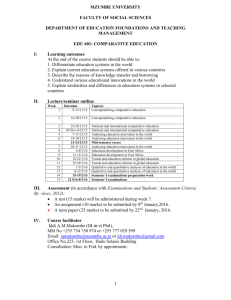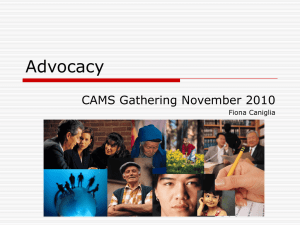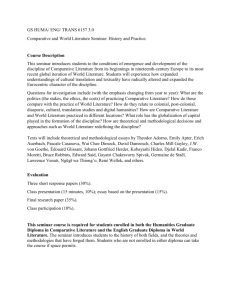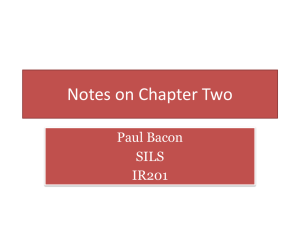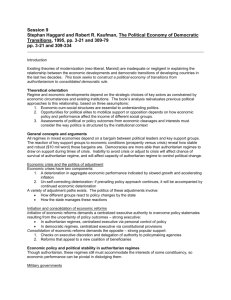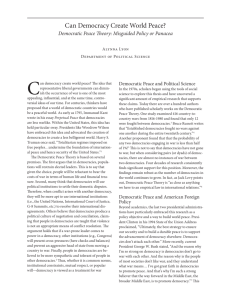Jordan Bankhead
advertisement
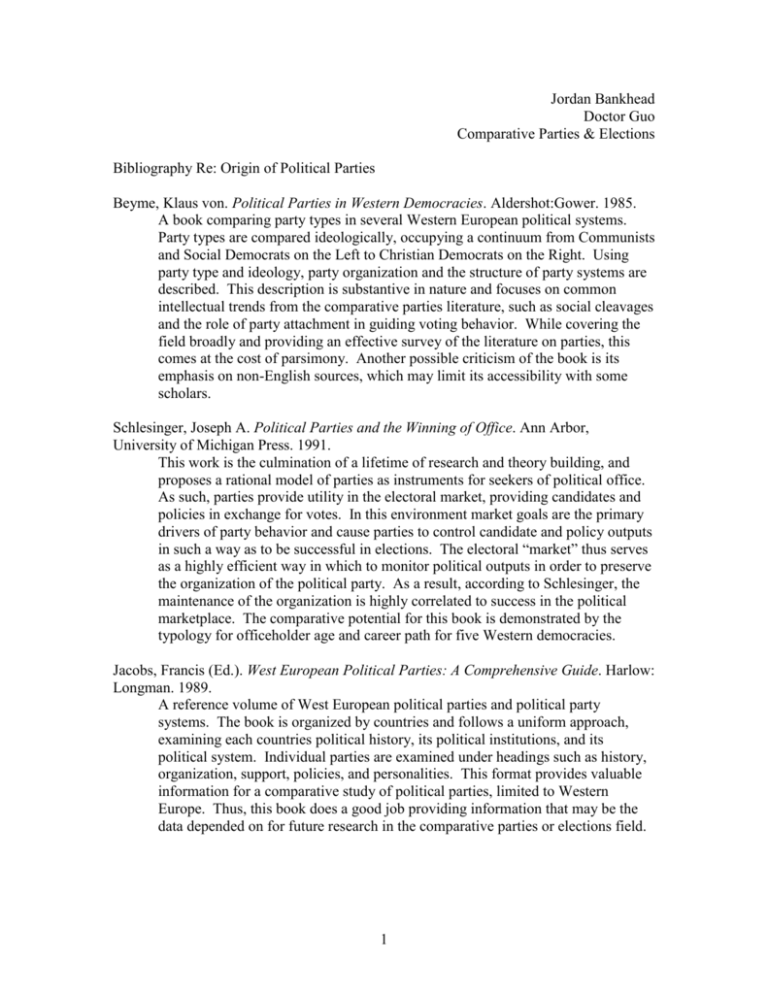
Jordan Bankhead Doctor Guo Comparative Parties & Elections Bibliography Re: Origin of Political Parties Beyme, Klaus von. Political Parties in Western Democracies. Aldershot:Gower. 1985. A book comparing party types in several Western European political systems. Party types are compared ideologically, occupying a continuum from Communists and Social Democrats on the Left to Christian Democrats on the Right. Using party type and ideology, party organization and the structure of party systems are described. This description is substantive in nature and focuses on common intellectual trends from the comparative parties literature, such as social cleavages and the role of party attachment in guiding voting behavior. While covering the field broadly and providing an effective survey of the literature on parties, this comes at the cost of parsimony. Another possible criticism of the book is its emphasis on non-English sources, which may limit its accessibility with some scholars. Schlesinger, Joseph A. Political Parties and the Winning of Office. Ann Arbor, University of Michigan Press. 1991. This work is the culmination of a lifetime of research and theory building, and proposes a rational model of parties as instruments for seekers of political office. As such, parties provide utility in the electoral market, providing candidates and policies in exchange for votes. In this environment market goals are the primary drivers of party behavior and cause parties to control candidate and policy outputs in such a way as to be successful in elections. The electoral “market” thus serves as a highly efficient way in which to monitor political outputs in order to preserve the organization of the political party. As a result, according to Schlesinger, the maintenance of the organization is highly correlated to success in the political marketplace. The comparative potential for this book is demonstrated by the typology for officeholder age and career path for five Western democracies. Jacobs, Francis (Ed.). West European Political Parties: A Comprehensive Guide. Harlow: Longman. 1989. A reference volume of West European political parties and political party systems. The book is organized by countries and follows a uniform approach, examining each countries political history, its political institutions, and its political system. Individual parties are examined under headings such as history, organization, support, policies, and personalities. This format provides valuable information for a comparative study of political parties, limited to Western Europe. Thus, this book does a good job providing information that may be the data depended on for future research in the comparative parties or elections field. 1 Panebianco, Angelo. Political Parties: Organization and Power. Cambridge. Cambridge University Press. 1988. An examination of the origin of political parties that takes into account their surrounding circumstances and environment. Party organization is strongly influenced by these background factors, which condition party goals and endows the organization with its basic power to accomplish its goals. Given the emphasis on organization, when the author attempts to distinguish between parties, an ideal type of the proper party organization emerges. This ideal type is used to explain the different developments of parties in separate countries. Differences are accounted for by different environmental conditions and goals while similarities are based more within the concept created of the ideal party organization. Dalton, Russell J. Citizen Politics in Western Democracies: Public Opinion and Political Parties in the United States, Great Britain, West Germany, and France. Chatham House. 1988. This book describes the evolution of political parties from elitist organizations dependent on a deferential citizenry to the modern mass-party that actively seeks to involve the electorate in party policy outputs in multifarious ways. Thus Dalton argues that social change supports a more active and involved citizenry in the political process. Parties have developed to meet these demands of citizens through adoption of popular policies with the public, such as the environment, healthcare, and social welfare measures. Using a cross-national survey of four leading democracies, Dalton finds that parties are in fact broadening their appeal to the public at large as he expected. The direction of the broader appeal parties are directing toward the public Dalton agrees is post-materialistic in value terms (drawing on Lipset-Rokkan). Thus policies that were once directed toward labor and the Left are now more nuanced and this reflects the post-materialist values of modern electorates. This leads to the conclusion for the author that individual attitudes are now more significant politically than monolithic large cohesive groups such as labor. Overall, Dalton does a good job tracing the theoretical development of parties literature and thus shows not only where we were but how we got to the place we are now at. Hoadley, John F. Origins of American Political Parties, 1789-1803. Lexington. University Press of Kentucky. 1986. The author traces the roots of political parties in the United States back to the dawn of the republic, finding the forerunners of major American parties in the competing system of norms and customs that were already developing at this stage. In fact, the major cleavage of the early period according to the author was sectional. Northerners were likely to belong to one party and Southerners were likely to belong to another. Because this state of affairs was actually borne out in realty when the Republicans became the party of the North and the Democrats the party predominantly of the South, this position finds support. To say these early norms and issue positions were parties, however, is not to say they can in any major way be compared to today’s major political parties. Nevertheless, the book 2 is important as it illustrates how political parties are strongly influenced by the historical circumstances of the country in which they arise. Lawson, Kay. Political Parties and Linkage: A Comparative Perspective. Yale University Press. 1980. This book is interesting inasmuch as it draws a link between the development of representative parties and the level of democracy. Parties that are elitist, for instance, are hypothesized to lie in less democratic countries while more representative parties are thought to be in more democratic countries. This expectation is put to the test by examining cases on “all populated continents” and among countries in each region of the world. What the author finds is that party type does play a role in whether the country is a democracy. This conclusion that linkage does exist between party character and democratic level, however, is subject to more rigorous analysis. Parties, it should be remembered, represent a subsection of the population and not necessarily the whole electorate. Thus, the claims made in this book that democratic parties equal democratic countries has not been definitively shown. 3




